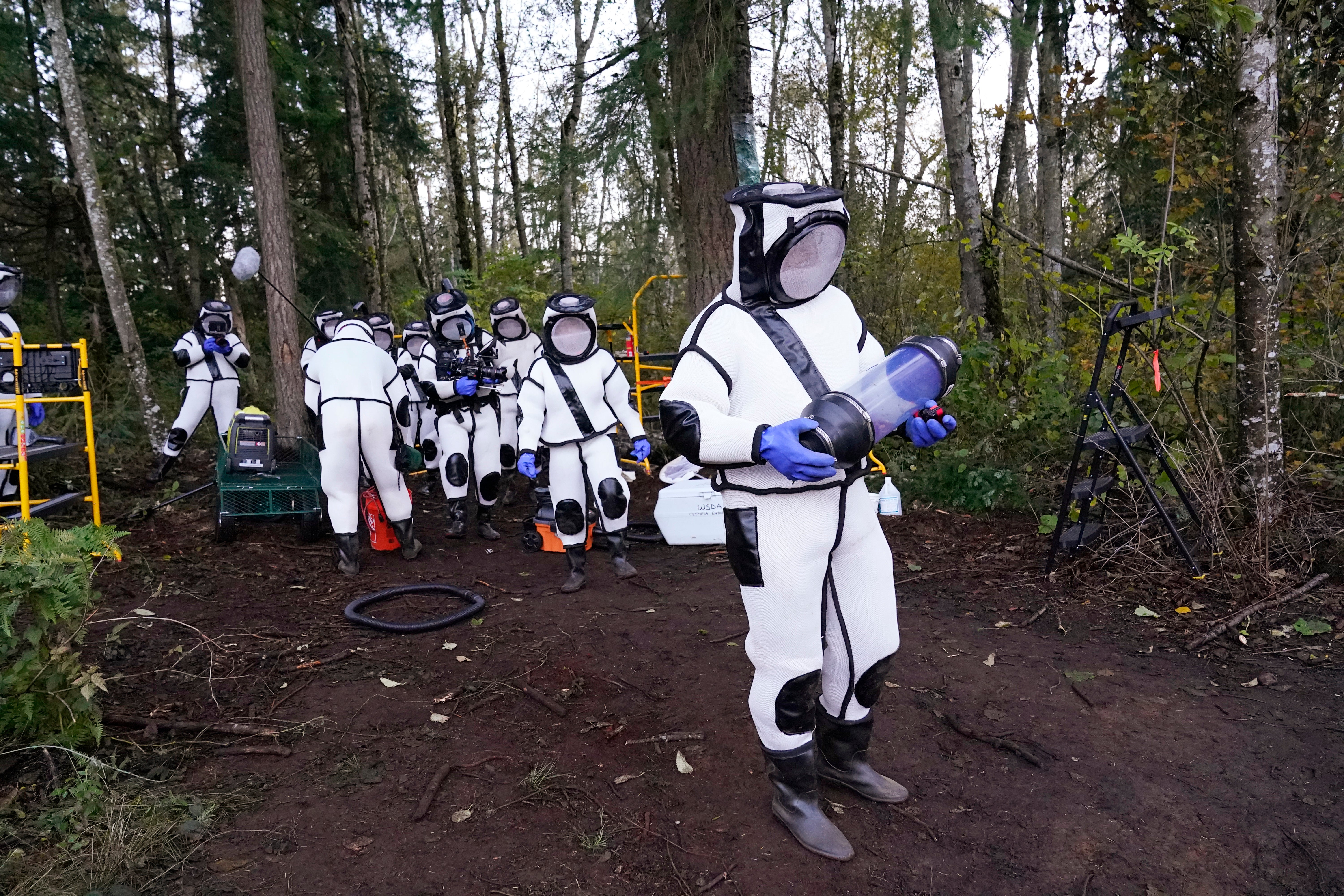Scientists continue search for murder hornet nests in Wash.
Scientists removed 98 so-called murder hornets from a nest discovered near the Canadian border in Washington state over the weekend, including 13 that were captured live in a net

Your support helps us to tell the story
From reproductive rights to climate change to Big Tech, The Independent is on the ground when the story is developing. Whether it's investigating the financials of Elon Musk's pro-Trump PAC or producing our latest documentary, 'The A Word', which shines a light on the American women fighting for reproductive rights, we know how important it is to parse out the facts from the messaging.
At such a critical moment in US history, we need reporters on the ground. Your donation allows us to keep sending journalists to speak to both sides of the story.
The Independent is trusted by Americans across the entire political spectrum. And unlike many other quality news outlets, we choose not to lock Americans out of our reporting and analysis with paywalls. We believe quality journalism should be available to everyone, paid for by those who can afford it.
Your support makes all the difference.Scientists removed 98 so-called murder hornets from a nest discovered near the Canadian border in Washington state over the weekend, including 13 that were captured live in a net, the state Department of Agriculture said Monday.
The other 85 Asian giant hornets were vacuumed into a special container when the first nest discovered on U.S. soil was eradicated on Saturday, the agency said.
“The eradication went very smoothly,'' managing entomologist Sven Spichiger said in a press release. “This is only the start of our work to hopefully prevent the Asian giant hornet from gaining a foothold in the Pacific Northwest.
"We suspect there may be more nests in Whatcom County '' Spichiger said.
Saturday’s operation began at about 5:30 a.m. with the team donning protective suits and setting up scaffolding around the tree so they could reach the opening of the nest, which was about 10 feet high. The team stuffed dense foam padding into a crevice above and below the nest entrance and wrapped the tree with cellophane, leaving just a single opening. This is where the team inserted a vacuum hose to remove the hornets from the nest.
Team members used a wooden board to whack the tree to encourage hornets to leave the nest, the agency said.
When the hornets stopped coming out of the nest, the team pumped carbon dioxide into the tree to kill or anesthetize any remaining hornets. They then sealed the tree with spray foam, wrapped it again with cellophane, and finally placed traps nearby to catch any potential survivors or hornets who may have been away during the operation and returned to the tree. The work was completed by 9 a.m.
“We congratulate the Washington State Department of Agriculture for eradicating this nest,” said Osama El-Lissy, Deputy Administrator of the U.S. Department of Agriculture’s Plant Protection and Quarantine program. “Thanks to their expertise and innovation, this nest is no longer a threat to honey bees in the area. ‘’
Entomologists will now try to determine whether the nest had begun to produce new queens.
WSDA will continue setting traps through at least November in hopes of catching any more Asian giant hornets still in Whatcom County.
WSDA has been actively searching for Asian giant hornet nests since the first hornets were caught earlier this year. The first confirmed detection of an Asian giant hornet in Washington was made in December 2019 and the first hornet was trapped in July of this year. Several more were subsequently caught, all in Whatcom County, which is in the northwestern corner of the state along the Canadian border.
Asian giant hornets, an invasive pest not native to the U.S., are the world’s largest hornet and a predator of honey bees and other insects. A small group of Asian giant hornets can kill an entire honey bee hive in a matter of hours.
Asian giant hornets can deliver painful stings to people and spit venom. Despite their nickname and the hype that has stirred fears in an already bleak year, the world’s largest hornets kill at most a few dozen people a year in Asian countries, and experts say it is probably far less. Meanwhile, hornets, wasps and bees typically found in the United States kill an average of 62 people a year, the Centers for Disease Control and Prevention has said.
The real threat from Asian giant hornets — which are 2 inches (5 centimeters) long — is their devastating attacks on honeybees, which are already under siege from problems like mites, diseases, pesticides and loss of food.
The invasive insect is normally found in China, Japan, Thailand, South Korea, Vietnam and other Asian countries. Washington state and the Canadian province of British Columbia are the only places the hornets have been found on the continent.
The nest was found after the state Agriculture Department trapped some hornets and used dental floss to attach radio trackers last week to some of them.